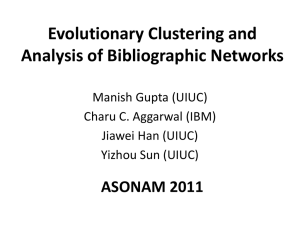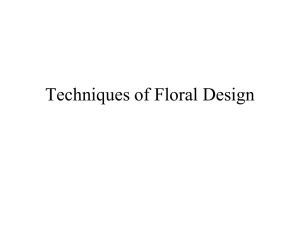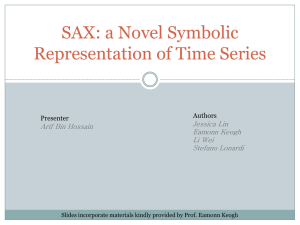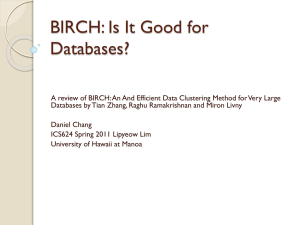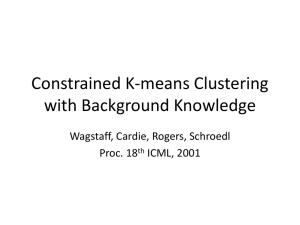k-medoid clustering with genetic algorithm
advertisement
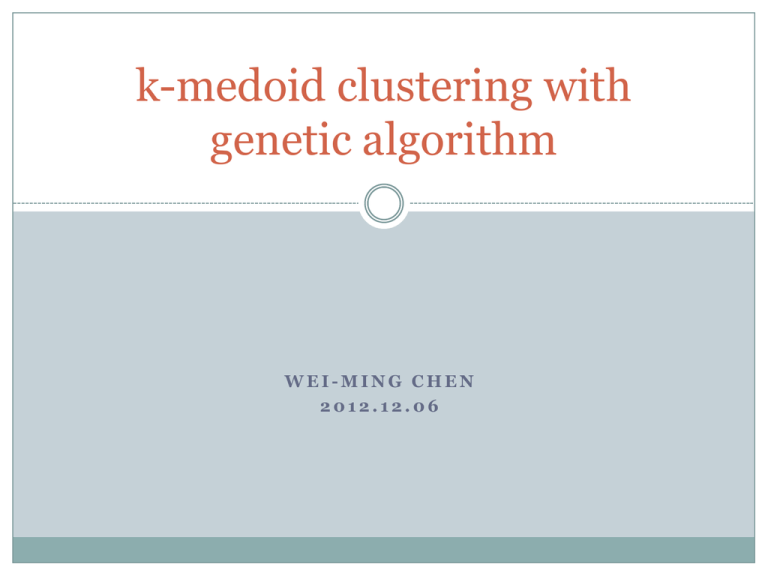
k-medoid clustering with
genetic algorithm
WEI-MING CHEN
2012.12.06
Outline
k-medoids clustering
famous works
GCA : clustering with the add of a genetic algorithm
Clustering genetic algorithm : also judge the number
of clusters
Conclusion
k-medoids clustering
famous works
GCA : clustering with the add of a genetic algorithm
Clustering genetic algorithm : also judge the number
of clusters
Conclusion
What is k-medoid clustering?
Proposed in 1987 (L. Kaufman and P.J. Rousseeuw)
There are N points in the space
k points are chosen as centers (medoids)
Classify other points into k groups
Which k points should be chosen to minimize the
summation of the points to its medoid
Difficulty
NP-hard
Genetic algorithms can be applied
k-medoid clustering
famous works
GCA : clustering with the add of a genetic algorithm
Clustering genetic algorithm : also judge the number
of clusters
Conclusion
Partitioning Around Medoids (PAM)
Kaufman, L., & Rousseeuw, P. J. (1990). Finding
groups in data: An introduction to cluster analysis.
New York: Wiley
Group N data into k sets
In every generation, select every pair of (Oi, Oj),
where Oi is a medoid and Oj is not, if replace Oi by Oj
would reduce the distance, replace Oi by Oj
Computation time : O(k(N-k)2) [one generation]
Clustering LARge Applications (CLARA)
Kaufman, L., & Rousseeuw, P. J. (1990). Finding
groups in data: An introduction to cluster analysis.
New York: Wiley
Reduce the calculation time
Only select s data in original N data
s = 40+2k seems a good choice
Computation time : O(ks2+k(n-k)) [one generation]
Clustering Large Applications based upon
RANdomized Search (CLARANS)
Ng, R., & Han, J. (1994). Efficient and effective
clustering methods for spatial data mining. In
Proceedings of the 20th international conference on
very large databases, Santiago, Chile (pp. 144–155)
Do not try all pairs of (Oi, Oj)
Try max(0.0125(k(N-k)), 250) different Oj to each Oi
Computation time : O(N2) [one generation]
k-medoids clustering
famous works
GCA : clustering with the add of a genetic
algorithm
Clustering genetic algorithm : also judge the number
of clusters
Conclusion
GCA
Lucasius, C. B., Dane, A. D., & Kateman, G. (1993).
On k-medoid clustering of large data sets with the
aid of a genetic algorithm: Background, feasibility
and comparison. Analytica Chimica Acta, 282, 647–
669.
Chromosome encoding
N data, clustering to k groups
Problem size = k (the number of groups)
each location of the string is an integer (1~N)
(a medoid)
Initialization
Each string in the population uniquely encodes a
candidate solution of the target problem
Random choose the candidates
Selection
Select M worst individuals in population and throw
them out
Crossover
Select some individuals for reproducing M new
population
Building-block like crossover
Mutation
Crossover
For example, k =3, p1 = 2 3 7, p2 = 4 8 2
1. Mix p1 and p2
Q = 21 31 71 42 82 22
randomly scramble : Q = 42 22 21 82 71 31
2. Add new material : first k elements may be changed
Q = 5 22 7 82 71 31
3. randomly scramble again
Q = 22 71 7 31 5 82
4. The offspring are selected from left or from right
C 1 = 2 7 3 , C2 = 8 5 3
Experiment
Under the limit of NFE < 100000
N = 1000, k = 15
Experiment
GCA versus Random search
Experiment
GCA versus CLARA (k = 15)
Experiment
GCA versus CLARA (k = 50)
Experiment
Paper’s conclusion
GCA can handle both large values of k and small
values of k
GCA outperforms CLARA, especially when k is a
large value
GCA lends itself excellently for parallelization
GCA can be combined with CLARA to obtain a
hybrid searching system with better performance.
k-medoids clustering
famous works
GCA : clustering with the add of a genetic algorithm
Clustering genetic algorithm : also judge the
number of clusters
Conclusion
Motivation
In some cases, we do not actually know the number
of clusters
If we only know the upper limit?
Hruschka, E.R. and F.F.E. Nelson. (2003). “A
Genetic Algorithm for Cluster Analysis.” Intelligent
Data Analysis 7, 15–25.
Fitness function
a(i) : the average distance of a individual to the
individual in the same cluster
𝑎(𝑖) =
𝐿
𝑗=1 𝑑𝑖𝑗
𝐿−1
d(i) : the average distance of a individual to the
individual in a different cluster
𝑑(𝑖, 𝐶) =
𝑀
𝑗=1 𝑑𝑖𝑗
𝑀
b(i) : the smallest of d(i, C)
𝑏(𝑖) = min(d(i, C))
Fitness function
Silhouette 𝑠 𝑖 =
fitness = 𝑠 =
𝑏 𝑖 −𝑎(𝑖)
max{𝑎 𝑖 ,𝑏(𝑖)}
𝑁
𝑖=1 𝑠(𝑖)
This value will be high when…
small a(i) values
high b(i) values
Chromosome encoding
N data, clustering to at most k groups
Problem size = N+1
each location of the string is an integer (1~k)
(belongs to which cluster )
Genotype1:
22345123453321454552 5
To avoid following problems:
Genotype2: 2|2222|111113333344444 4
Genotype3: 4|4444|333335555511111 4
Child2:
2 4444 111113333344444 4
Child3:
4 2222 333335555511111 5
Consistent Algorithm : 11234512342215343441 5
Initialization
Population size = 20
The first genotype represents two clusters,
the second genotype represents three clusters,
the third genotype represents four clusters, . . . , and
the last one represents 21 clusters
Selection
roulette wheel selection
−1 ≤ 𝑠(𝑖) ≤ 1
normalize to 0 ≤ 𝑠(𝑖) ≤ 2
Crossover
Uniform crossover do not work
Use Grouping Genetic Algorithm (GGA), proposed
by Falkenauer (1998)
First, two strings are selected
A − 1123245125432533424
B − 1212332124423221321
Randomly select groups to preserve in A
(For example, group 2 and 3)
Crossover
A − 1123245125432533424
B − 1212332124423221321
C − 0023200020032033020
Check the unchanged group in B and place in C
C − 0023200024432033020
Another child : form by the groups in B (without
which is actually placed in C)
D − 1212332120023221321
Crossover
A − 1123245125432533424
B − 1212332124423221321
C − 0023200024432033020
Another child : form by the groups in B (without
which is actually placed in C)
D − 1212332120023221321
Check the unchanged group in A and place in D
The other objects (whose alleles are zeros) are placed
to the nearest cluster
Mutation
Two ways for mutation
1. randomly chosen a group, places all the objects to
the remaining cluster that has the nearest centroid
2. divides a randomly selected group into two new
ones
Just change the genotypes in the smallest possible
way
Experiment
4 test problems (N = 75, 200, 699, 150)
Experiment
Ruspini data (N = 75)
Paper’s conclusion
Do not need to know the number of groups
Find out the answer of four different test problems
successfully
Only on small population size
k-medoids clustering
famous works
GCA : clustering with the add of a genetic algorithm
Clustering genetic algorithm : also judge the number
of clusters
Conclusion
Conclusion
Genetic algorithms is an acceptable method for
clustering problems
Need to design crossover carefully
Maybe EDAs can be applied
Some theses? Or final projects!
